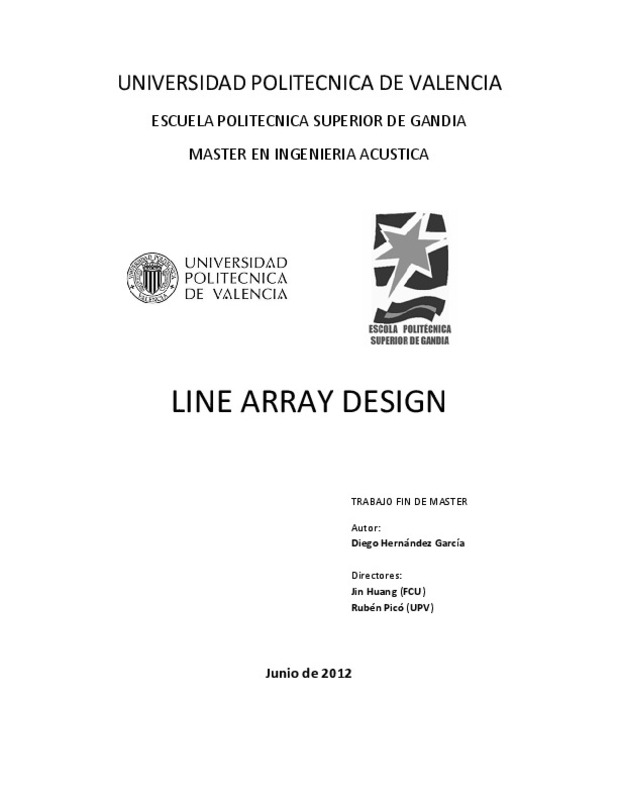JavaScript is disabled for your browser. Some features of this site may not work without it.
Buscar en RiuNet
Listar
Mi cuenta
Estadísticas
Ayuda RiuNet
Admin. UPV
Line array design
Mostrar el registro sencillo del ítem
Ficheros en el ítem
| dc.contributor.advisor | Picó Vila, Rubén
|
es_ES |
| dc.contributor.author | Hernández García, Diego José
|
es_ES |
| dc.date.accessioned | 2013-01-23T13:14:48Z | |
| dc.date.available | 2013-01-23T13:14:48Z | |
| dc.date.created | 2012-06-28 | |
| dc.date.issued | 2013-01-23 | |
| dc.identifier.uri | http://hdl.handle.net/10251/18486 | |
| dc.description.abstract | This master thesis is devoted to study the acoustic and psycho¿acoustic characteristics of binaural reproductions on speaker line arrays. The main goal is to study the beamforming theory and its validation by comparing with measured results. In addition, some applications for line speaker arrays are presented. Beamforming and its applications have been investigated in recent decades. However, the rapid growth of technology requires smaller speakers in order to install them in devices like flat televisions, laptops, cell¿phones or electronic tables. Therefore, this thesis work will focus in small size speakers and low power applications suitable for domestic and portable audio reproduction. With transaural audio reproduction it is possible to provide a virtual environment where the source locations are perceived at positions where no physical sources exist. Headphones can be used to reproduce binaural signals due to the low crosstalk they offer. Even thought, in some applications for convenience loudspeakers are preferred, undesired signal arrives to the contralateral ear. To improve the crosstalk and sensation of separated channels this thesis presents the using of line arrays for binaural audio reproduction. Psychoacoustic cues to guess where the sound source is located or Head Related Transfer Functions are used in combination with beamformers to obtain trans¿aural audio reproduction. In order to design and simulate line arrays Graphical User Interfaces will be presented. Programmed by Matlab, they offer a tool to design and study the beamformers. By introducing the characteristics of the line array, different directivity representations and useful parameters will be given. It also allows the simulation by using real speaker directivities previously measured. To validate the simulation of line arrays, different measurements will be carried out in an anechoic chamber by using a turn table controller. This thesis describes an audio system composed of signal processor, amplifiers and speaker line array that can be used to generate directional steerable beams and transaural audio reproduction. In order to amplify the signal to the speakers, the design and construction of an eight¿channel amplifier will be explained in detail. | es_ES |
| dc.format.extent | 110 | es_ES |
| dc.language | Inglés | es_ES |
| dc.publisher | Universitat Politècnica de València | es_ES |
| dc.rights | Reserva de todos los derechos | es_ES |
| dc.subject | Radiación | es_ES |
| dc.subject | Formación de haces | es_ES |
| dc.subject | Altavoces | es_ES |
| dc.subject | Audio digital | es_ES |
| dc.subject | Transaural audio | es_ES |
| dc.subject | Arrays | es_ES |
| dc.subject.other | Máster Universitario en Ingeniería Acústica-Màster Universitari en Enginyeria Acústica | es_ES |
| dc.title | Line array design | es_ES |
| dc.type | Tesis de máster | es_ES |
| dc.rights.accessRights | Abierto | es_ES |
| dc.contributor.affiliation | Universitat Politècnica de València. Departamento de Física Aplicada - Departament de Física Aplicada | es_ES |
| dc.contributor.affiliation | Universitat Politècnica de València. Instituto de Investigación para la Gestión Integrada de Zonas Costeras - Institut d'Investigació per a la Gestió Integrada de Zones Costaneres | es_ES |
| dc.contributor.affiliation | Universitat Politècnica de València. Escuela Politécnica Superior de Gandia - Escola Politècnica Superior de Gandia | es_ES |
| dc.description.bibliographicCitation | Hernández García, DJ. (2012). Line array design. Universitat Politècnica de València. http://hdl.handle.net/10251/18486 | es_ES |
| dc.description.accrualMethod | Archivo delegado | es_ES |
Este ítem aparece en la(s) siguiente(s) colección(ones)
-
EPSG - Trabajos académicos [5004]
Escuela Politécnica Superior de Gandia






